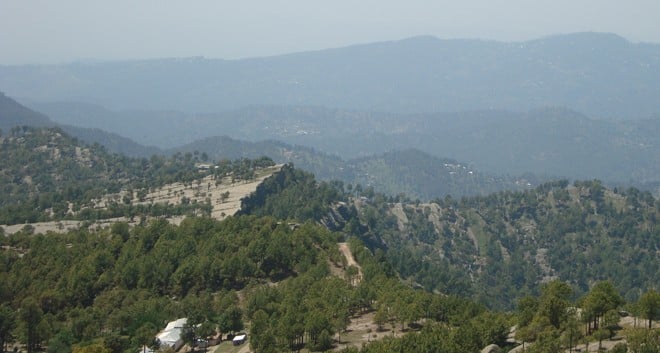

The fable of Panj Peer -- five holy men who meditated up in the mountains for over 1,000 years -- had always intrigued me. So, one sunny morning in May, a team of three barely fit souls, including me, left Islamabad for Lehtrar. It took us an hour to reach Lehtrar, where we had our morning tea with cake rusks at the local kiosk.
We were on the road again for another 10 kilometres to reach Chaint where we left the main Lehtrar Kotli Sattian road to drive on a branch road to Danoi forest rest house about six kilometres up in the mountains.
The 1928 Danoi rest house is a typical colonial-era forest rest house nestled in dense pine forest -- and is reasonably maintained. The visitors’ book of these rest houses is always a treat to read. However, unfortunately the Danoi visitors’ book is apparently deposited with the Divisional Forest Office to keep it safe. The rest house can be booked for a night’s stay from DFO office in Rawalpindi. Otherwise, if you’re nice to the caretaker, he may oblige.
Arriving at the rest house early in the morning, we looked for the caretaker, calling out for him and after a while he emerged from somewhere in the forest. We asked if we could park our car while we went for a 4-5 hours hike to Panj Peer shrine on the ridge. He reluctantly agreed telling us that only a night before, someone broke into a guest’s parked car and stole some stuff. We did not feel reassured especially seeing a loaded pistol in his hand. He also offered tea on our return from the hike which we obviously accepted.
So, off we went on the road upward from the Danoi forest rest house. We had been told by friends and various travel blogs to park our car at the rest house and being the conformists we are, we obediently followed the instructions only to find out after almost an hour’s hike that the car could have been parked further up the road near a small settlement and we could have taken the forest trek from there.
After an hour of walking on the road, we were finally on the jungle trek -- also called the Bridle Path in forestry terms. In colonial times, sahibs used to travel either on horses or palkis and the treks needed to be wide enough to allow either horses or palkis.
We walked on Danoi ridge, surrounded by dense pine forest, for an hour. The forest is unique with huge boulders all around and one can see the deep Jhelum valley to the left with River Jhelum flowing at the bottom of the valley on its way to Mangla Dam.
After an hour-long walk in the jungle, we reached the rocky part of the ridge with huge slant boulders and negligible vegetation. Panj Peer rocks derive their name from this rocky face of the ridge.
By now we had seen the rocks this hike is famous for; however, the shrine was another 30 minutes away and, after three hours of strenuous hike, our limbs were refusing to take instructions. While cursing ourselves for the decision to hike, we chugged along and after negotiating our way through a small village, we reached the immaculately kept Panj Peer shrine at the top of the mountain.
The winters are harsh in the Panj Peer village and it is covered with snow for two to three months. To our surprise, there was actually a jeep road all the way up to the Panj Peer village from Narar village in Kahuta. So if you are only interested in reaching the shrine, take a jeep to reach there directly.
The Panj Peer shrine or the shrine of five holy men is not a grave but actually a meditation place of the five holy men. The legend is that these holy men lived for over a 1,000 years; they meditate here and in other places like Peshawar, Kohat, Bengal and Kashmir. Without going into the veracity of the legend, the old Banyan tree in the courtyard does point to at least a couple of hundred years of history. We had our lunch and rest in the cool courtyard and then it was time to head back.
Trekkers know that while it appears that walking down the hill is easier as it does not make you pant, it surely is taxing for your knees and toes. From here to Danoi forest rest house, it is around a six hours trek, but you can reduce the trek time by about two hours by parking your vehicle a couple of kilometeres up from Danoi forest rest house near a small settlement.
It is strongly recommended to take plenty of water with you and keep on checking directions from locals. Lastly, the best time for the trek is either spring or autumn to avoid extreme weather.